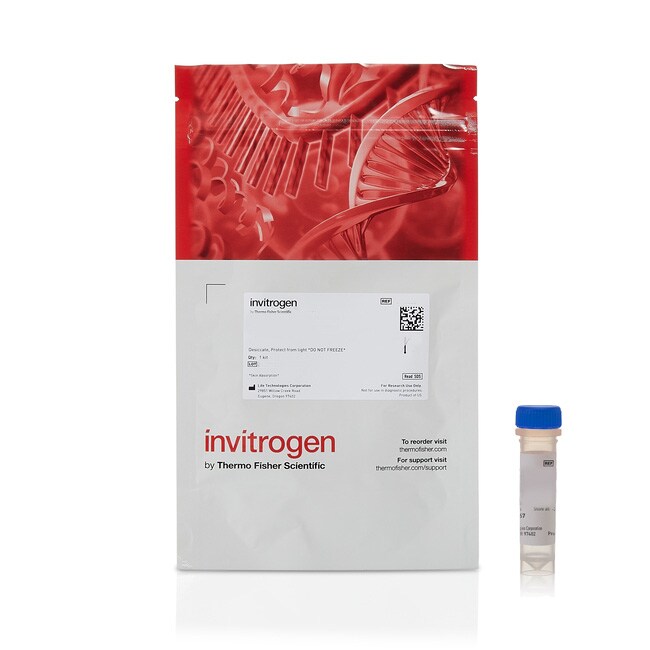
Alexa Fluor™ 660 is a bright, far-red fluorescent dye. Used for stable signal generation in imaging and flow cytometry, Alexa Fluor™ 660 dye is water soluble and pH-insensitive from pH 4 to pH 10.
The maleimide derivative of Alexa Fluor™ 660 is the most popular tool for conjugating the dye to a thiol group on a protein, oligonucleotide thiophosphate, or low molecular weight ligand. The resulting Alexa Fluor™ 660 conjugates exhibit brighter fluorescence and greater photostability than the conjugates of other spectrally similar fluorophores.
Detailed information about this AlexaFluor™ maleimide:
Fluorophore label: Alexa Fluor™ 660 dye
Reactive group: maleimide
Reactivity: thiol groups on proteins and ligands, oligonucleotide thiophosphates
Ex/Em of the conjugate: 668/697 nm
Extinction coefficient: 112,000 cm-1M-1
Molecular weight: ∼1000
Typical Conjugation Reaction
The protein should be dissolved at a concentration of 50-100 μM in a suitable buffer (10-100 mM phosphate, Tris, or HEPES) at pH 7.0-7.5. In this pH range, the protein thiol groups are sufficiently nucleophilic that they react almost exclusively with the reagent in the presence of the more numerous protein amine groups, which are protonated and relatively unreactive. We recommend reducing any disulfide bonds at this point using a 10-fold molar excess of reducing agent such as DTT or TCEP. Excess DTT must be removed by dialysis and subsequent thiol-modification should be carried out under oxygen-free conditions to prevent reformation of the disulfide bonds; these precautions are not necessary when using TCEP prior to maleimide conjugation.
The Alexa Fluor™ maleimide is typically dissolved in high-quality anhydrous dimethylsulfoxide (DMSO) at a concentration of 1-10 mM immediately prior to use, and stock solutions should be protected from light as much as possible. Generally, this stock solution is added to the protein solution dropwise while stirring to produce approximately 10-20 moles of reagent per mole of protein, and the reaction is allowed to proceed at room temperature for 2 hours or at 4°C overnight, protected from light. Any unreacted thiol-reactive reagent can be consumed by adding excess glutathione, mercaptoethanol, or other soluble low molecular weight thiol.
Conjugate Purification
Labeled antibodies are typically separated from free Alexa Fluor™ dye using a gel filtration column, such as Sephadex™ G-25, BioGel™ P-30, or equivalent. For much larger or smaller proteins, select a gel filtration media with an appropriate molecular weight cut-off or purify by dialysis. We offer several purification kits optimized for different quantities of antibody conjugate:
Antibody Conjugate Purification Kit for 0.5-1 mg (A33086)
Antibody Conjugate Purification Kit for 20-50 μg (A33087)
Antibody Conjugate Purification kit for 50-100 μg (A33088)
Learn More About Protein and Antibody Labeling
We offer a wide selection of Molecular Probes™ antibody and protein labeling kits to fit your starting material and your experimental setup. See our Antibody Labeling kits or use our Labeling Chemistry Selection Tool for other choices. To learn more about our labeling kits, read Kits for Labeling Proteins and Nucleic Acids—Section 1.2 in The Molecular Probes™ Handbook.
We’ll Make a Custom Conjugate for You
If you can’t find what you’re looking for in our online catalog, we’ll prepare a custom antibody or protein conjugate for you. Our custom conjugation service is efficient and confidential, and we stand by the quality of our work. We are ISO 13485:2000 certified.
| Code | Description |
|---|---|
| A20343 | Catalog Number: A20343 |

